Study of a model racing chariot on display at the British Museum provides little-known insight into how they might have been built in ancient Rome.
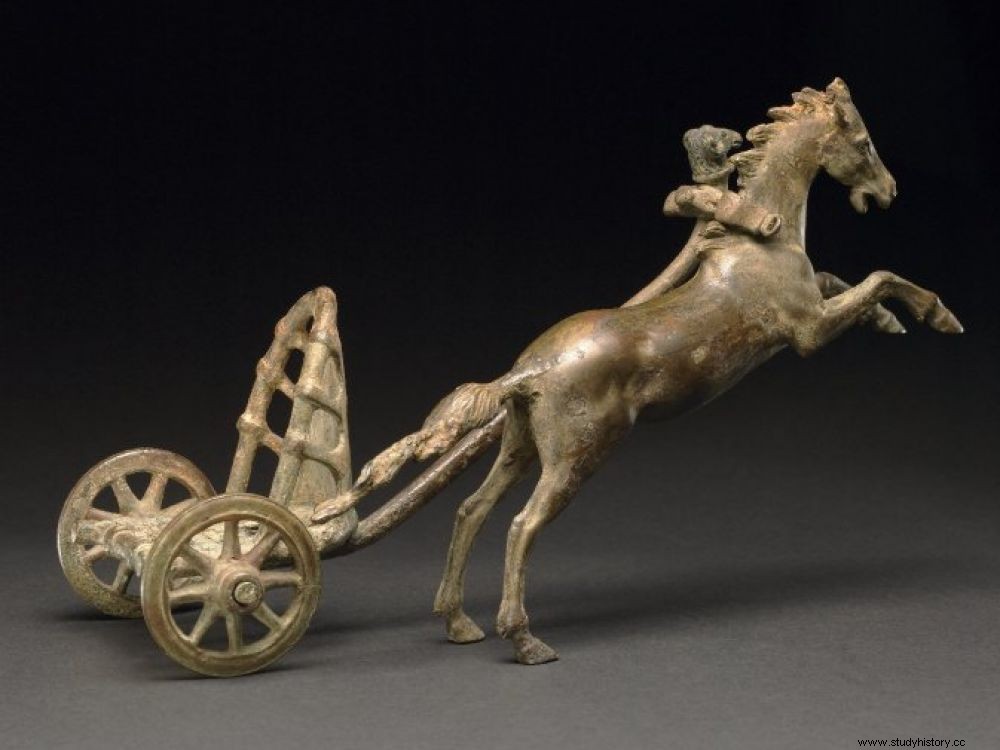
1 st miniature Roman racing chariot century of our era, discovered in the Tiber (Rome), in 1894, and today exhibited in the British Museum (London). The charioteer and a second mount have disappeared.
“Stop your chariot! goes the famous popular saying… Yes, but how? The recent study of a scale model of a Roman chariot from the 1 st century of our era exhibited in the collections of the British Museum (London) perhaps provides an element of the answer as to how these racing vehicles could have been built. Because, as surprising as it may seem, specialists have not fully resolved these questions, no original model of ancient racing chariot having come down to us! Even less those used in the great circuses of the Roman Empire such as the Circus Maximus in Rome (150,000 seats) or that of Constantinople. On the biga (bige) bronze miniature exhibited in London - a two-wheeled racing chariot drawn by two horses - Bela Sandor, professor emeritus of physical engineering at the University of Wisconsin in Madison (United States), thought he detected, in the perfectly reproduced prototype, the presence of an iron strapping on the right wheel.
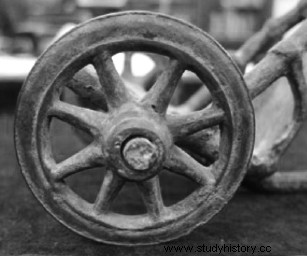
Close-up of the right wheel of the model racing tank on display in the British Museum. It wears an iron strapping, missing from the left wheel. © Bela Sandor/British Museum.
With an iron-rimmed right wheel, the driver increased his chances of victory by 80%!
In an article published in the prestigious journal Journal of Roman Archeology , he hypothesizes that this device would have increased the chances of victory of a charioteer (driver) by 80% by allowing him to better orient him in the turns. "With the races taking place in an anti-clockwise direction, when the left turn was taken, the driver and the tank veered to the right, the reinforced right wheel allowed the structure to tolerate this transfer extra weight without breaking apart », Explains the expert contacted by Sciences et Avenir. Because the concern of the charioteers was to avoid at all costs the "naufragium this "going off the road" that sent them "into the wall" where they could die crushed or dragged hundreds of yards by the runaway horses, due to their custom of wrapping the reins around their cut. Carrying a dagger normally allowed them to cut these bridles in case of danger. Adored by the crowd, these "sporting idols" of the time - who pocketed real fortunes - dreaded more than anything the sinister exit through the "gate of the dead" (porta libitinensis) , which any arena had.
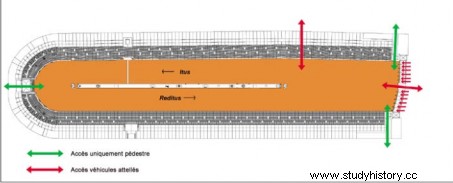
Reconstruction of the hippodrome of Leptis Magna, in Libya. In red, teams entering their stalls from the outside. At the top, the red arrow indicates the porta libitinensis , the gate of the dead through which the wounded were evacuated. Credit:Fabricia Fauquet
“Very few specialists have worked on these issues “, explains Fabricia Fauquet, research engineer at the INAMA Laboratory, the National School of Architecture in Marseille, for whom the iron strapping on the right wheel of the rod could be one trick among others. A specialist in the technical constraints that these chariots may have presented to better understand the architecture possessed by ancient circuses, in a remarkable thesis, the expert relied on the experimental archeology work of Jean Spruytte, a charrerie specialist who has reproduced Egyptian, Greek and Roman chariots in real size, to study how they work. The models of race tanks, very light, had nothing to do with the so-called "triumph" or war tanks, too heavy, which nevertheless made the success of the most famous of the races imagined by Hollywood in Ben Hur . "Hundreds of people (veterinarians, mechanics, etc.) worked together in the different "stables" of the time. Each had to have their own "secrets" to achieve victory “, explains Fabricia Fauquet.
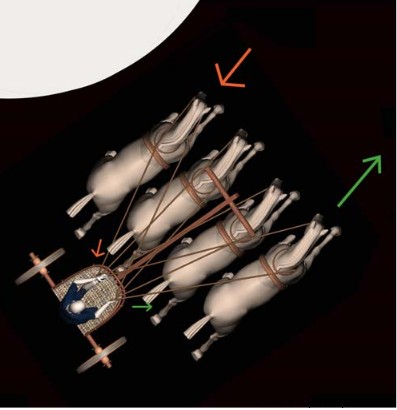
3D simulation of a quadriga taking a turn in an ancient racecourse. © Fabricia Fauquet
"The most important races were those of quadrigae, with four horses, which were very dangerous because there was no technique then to connect the animals together", she continues. The horses were positioned in pairs on either side of the drawbar, all the skill of the charioteer consisting in directing the team frontally, then, when approaching the bend, releasing the horse on the left to better train the three more in the curve. “ Each horse in the team having a different role, it cannot be excluded that certain specificities have been brought to the wheels. The presence of unilateral iron strapping on some prototypes is therefore an interesting hypothesis concludes the researcher.

Reconstruction:detail of five of the twelve floats at the start of a race in the Circus Maximus in Rome. © Fabricia Fauquet
Each race consisted of twelve teams, represented by four "factions" (stables) of different colors (white, blue, red, green). Each engaged three of these crews. After an opening ceremony and a drawing of lots, each chariot was assigned to a starting stall, closed by a small wooden gate awaiting a double starting signal:the first -visual- was given by the 'editor (the emperor financing the games) throwing a white towel, immediately followed by an audible signal triggering the instantaneous opening of the twelve gates. The tanks then rushed on the track with a formal ban on overtaking until the passage of the first marker located on the spina (thorn) , the wall located in the heart of the oval circus separating the track in two. Past the "starting line", materialized on the ground just under the judges' stand, the horses could finally be released. The race was won by the tank which crossed the finish line first after completing seven laps. The charioteer then had about 100 to 200m to stop his horses running at full speed.
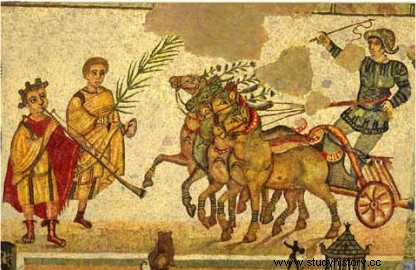
Charioteer winner. Note the reins wrapped around the waist. © Fabricia Fauquet
